Tacoma Narrows Bridge history - Bridge - Lessons from failure
Lessons from the failure of a great machine
How Galloping Gertie's collapse left us a lasting design legacy.
What's here?
- The damage
- First investigations - Partial answers to "why"
- "Blind spot" - Design lessons of Gertie's failure
- End of an era
- Suspension bridge design since 1940
- Why did Galloping Gertie collapse?
- What if....
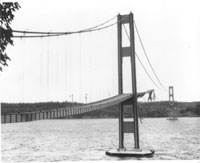
The bridge in ruins, looking southwest, November 1940. The copyright in this image is the property of the Tacoma Public Library. Any additional copies or reproduction of this image are prohibited. All rights reserved
The damage
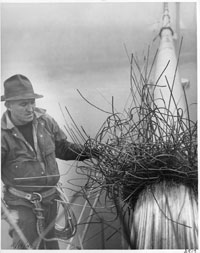
A bridge inspector checks The damaged cable WSDOT
Main cables
During the collapse, the main suspension cables were thrown violently side to side, twisted, and tossed 100 feet into the air. They slipped from their positions in the cable saddles atop each tower. And, they fell hard on the approach spans. On the north cable at mid-span, where the cable band loosened, it broke more than 350 wires. Other wires were severely stressed and distorted. The main cables were a total loss, but salvage was undertaken. Their only value was as scrap metal.
Suspender cables
The violent collapse broke many suspender cables. Some were lost, some severely damaged, and some undamaged. Their only value now was as scrap metal.
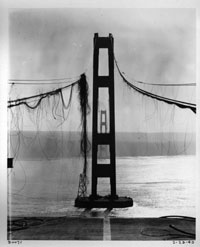
View of damaged cables and towers looking west, February 1943 WSDOT
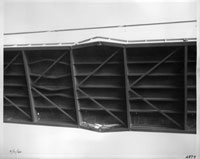
View from below the deck at buckled steel beams WSDOT
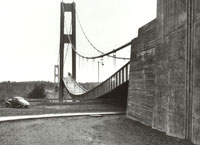
M3-5 Sagging east side span GHM, Bashford 2795
Towers
The main towers (West Tower, #4; and East Tower, #5), including the bracing struts, were twisted and bent. Stress beyond the elastic limit of the metal resulted in buckling and permanent distortion. Their only value now was as scrap metal.
Deck-floor system
Not surprisingly, the concrete and steel of the center span that now lay on the bottom of the Narrows was deemed a total loss. The remainder of the broken concrete on the side spans needed removal. The floor system had sections that were bent and overstressed. Their only value now was as scrap metal.
Side spans
The loss of the center section, followed by the dropping of the side spans, caused substantial damage. The events stressed and distorted the plate girders and floor beams. Some buckled beyond repair.
Piers
Both the West Pier (#4) and the East Pier (#5) sustained no damage. The collapse of the center span caused partial sheering of rivets that attached the towers to the tops of the piers.
Anchorages
The anchorages for the main cables were undamaged. For building a replacement bridge, removal of part of the concrete would be necessary in order to spin the new main cables.
First investigations - Partial answers to "why"
The collapse of the 1940 Tacoma Narrows Bridge stunned everyone, especially engineers. How could the most "modern" suspension bridge, with the most advanced design, suffer catastrophic failure in a relatively light wind?
The State of Washington, the insurance companies, and the United States government appointed boards of experts to investigate the collapse of the Narrows Bridge. The Federal Works Administration (FWA) appointed a 3-member panel of top-ranking engineers: Othmar Amman, Dr. Theodore Von Karmen, and Glen B. Woodruff. Their report was the Administrator of the FWA, John Carmody and became known as the "Carmody Board" report.
In March 1941 the Carmody Board announced its findings. "Random action of turbulent wind" in general, said the report, caused the bridge to fail. This ambiguous explanation was the beginning of attempts to understand the complex phenomenon of wind-induced motion in suspension bridges. Three key points stood out:
(1) The principal cause of the 1940 Narrows Bridge's failure was its "excessive flexibility;"
(2) the solid plate girder and deck acted like an aerofoil, creating "drag" and "lift;"
(3) aerodynamic forces were little understood, and engineers needed to test suspension bridge designs using models in a wind tunnel.
"The fundamental weakness" of the Tacoma Narrows Bridge, said a summary article published in Engineering News Record, was its "great flexibility, vertically and in torsion." Several factors contributed to the excessive flexibility: The deck was too light. The deck was too shallow at 8 feet (a 1/350 ratio with the center span). The side spans were too long, compared with the length of the center span. The cables were anchored at too great a distance from the side spans. The width of the deck was extremely narrow compared with its center span length, an unprecedented ratio of 1 to 72.
The pivotal event in the bridge's collapse, said the Board, was the change from vertical waves to the destructive twisting, torsional motion. This event was associated with the slippage of the cable band on the north cable at mid-span. Normally, the main cables are of equal length where the mid-span cable band attaches them to the deck. When the band slipped, the north cable became separated into two segments of unequal length. The imbalance translated quickly to the thin, flexible plate girders, which twisted easily. Once the unbalanced motion began, progressive failure followed.
The investigation Board's most significant finding was simple and obvious: the engineering community must study and better understand aerodynamics in designing long suspension bridges.
Meanwhile, Professor F. B. Farquharson continued wind tunnel tests. He concluded that the "cumulative effected of undampened rhythmic forces" had produced "intense resonant oscillation." In other words, the bridge's lightness, combined with an accumulation of wind pressure on the 8-foot solid plate girder and deck, caused the bridge to fail.
Leon Moisseiff, who was contacted immediately after the failure, said he was "completely at a loss to explain the collapse." Moisseiff visited the ruined bridge one week later, touring under the watchful eye of Clark Eldridge. Moisseiff's design, while pushing beyond the boundaries of engineering practice, fully met the requirements of accepted theory at the time.
"Blind spot" - Design lessons of Gertie's failure
At the time the 1940 Narrows Bridge failed, the small community of suspension bridge engineers believed that lighter and narrower bridges were theoretically and functionally sound. In general, leading suspension bridge designers like David Steinman, Othmar Amman, and Leon Moisseiff determined the direction of the profession. Very few people were designing these huge civil works projects. The great bridges were extremely expensive. They presented immensely complicated problems of engineering and construction. The work was sharply limited by government regulation, various social concerns, and constant public scrutiny. A handful of talented engineers became pre-eminent. But, they had what has been called a "blind spot."
That "blind spot" was the root of the problem. According to bridge historian David P. Billington, at that time among suspension bridge engineers, "there seemed to be almost no recognition that wind created vertical movement at all."
The best suspension bridge designers in the 1930s believed that earlier failures had occurred because of heavy traffic loading and poor workmanship. Wind was not particularly important. Engineers viewed stiffening trusses as important for preventing sideways movement (lateral, or horizontal deflection) of the cables and the roadway. Such motion resulted from traffic loads and temperature changes, but had almost nothing to do with the wind.
This trend ran in virtual ignorance of the lessons of earlier times. Early suspension bridge failures resulted from light spans with very flexible decks that were vulnerable to wind (aerodynamic) forces. In the late 19th century engineers moved toward very stiff and heavy suspension bridges. John Roebling consciously designed the 1883 Brooklyn Bridge so that it would be stable against the stresses of wind. In the early 20th century, however, says David P. Billington, Roebling's "historical perspective seemed to have been replaced by a visual preference unrelated to structural engineering."
Just four months after Galloping Gertie failed, a professor of civil engineering at Columbia University, J. K. Finch, published an article in Engineering News-Record that summarized over a century of suspension bridge failures. In the article, titled "Wind Failures of Suspension Bridges or Evolution and Decay of the Stiffening Truss," Finch reminded engineers of some important history, as he reviewed the record of spans that had suffered from aerodynamic instability. Finch declared, "These long-forgotten difficulties with early suspension bridges, clearly show that while to modern engineers, the gyrations of the Tacoma bridge constituted something entirely new and strange, they were not new--they had simply been forgotten."
An entire generation of suspension bridge designer-engineers forgot the lessons of the 19th century. The last major suspension bridge failure had happened five decades earlier, when the Niagara-Clifton Bridge fell in 1889. And, in the 1930s, aerodynamic forces were not well understood at all.
"The entire profession shares in the responsibility," said David Steinman, the highly regarded suspension bridge designer. As experience with leading-edge suspension bridge designs gave engineers new knowledge, they had failed to relate it to aerodynamics and the dynamic effects of wind forces.
End of an era
The collapse of Galloping Gertie on November 7, 1940 revealed the limitations of the "deflection theory." Now, engineers no longer believed that suspension bridges needed to be stiffened only against the stress of moving vehicles and the "minor" effect of wind.
The failure of the Tacoma Narrows Bridge effectively ended Moisseiff's career. More importantly, it abruptly ended an entire generation of bridge engineering theory and practice, and the trend in designing increasingly flexible, light, and slender suspension spans.
Othmar Amman said of the collapse of the 1940 Narrows Bridge, "Regrettable as the Tacoma Narrows Bridge failure and other recent experiences are, they have given us invaluable information and have brought us closer to the safe and economical design of suspension bridges against wind action."
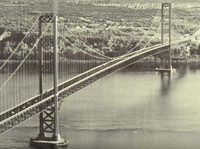
Aerial view of 1950 Narrows Bridge WSDOT
Suspension bridge design since 1940
"Mere size and proportion are not the outstanding merit of a bridge; a bridge should be handed down to posterity as a truly monumental structure which will cast credit on the aesthetic sense of present generations." - Othmar H. Amman, 1954
The end of the 1950s witnessed the construction of two of the greatest suspension bridges in the world, built by two of the 20th century's greatest bridge engineers. The Mackinac Strait Bridge, which opened in November 1957 in Michigan, was the crowning achievement of David B. Steinman. In New York the Verazzano-Narrows Bridge, designed by Othmar Amman, was 10 years in the making and finally opened in November 1964. Both of these monumental spans directly benefited from the legacies of the failed 1940 and the successful 1950 Tacoma Narrows Bridges.
Over the course of the last 60 years since Galloping Gertie failed, bridge engineers have created suspension bridges that are aerodynamically streamlined, or stiffened against torsional motion, or both.
Now, wind tunnel testing for aerodynamic effects on bridges is commonplace. In fact, the United States government requires that all bridges built with federal funds must first have their preliminary design subjected to wind tunnel analysis using a 3-dimensional model.
Failure of the 1940 Tacoma Narrows Bridge revealed for the first time limitations of the Deflection Theory. Since the Tacoma disaster, aerodynamic stability analysis has come to supplement the theory, but not replace it. The Deflection Theory remains an integral part of suspension bridge engineering. Today, the theory's principles serve as a model for the complex analytical methods (such as "Finite Element" computer programs) used by structural engineers to calculate stresses in the suspension Cable system.
Since the 1990s, advances in computer graphics technology and high-speed processing have enabled such calculations to be performed on desktop computers. Today, engineers recognize the importance of a thorough aerodynamic analysis of the structures they design. Advanced modeling software programs assist the complex calculations.
Why did Galloping Gertie collapse?
For over six decades, engineers have studied the collapse of the 1940 Tacoma Narrows Bridge. The experts disagree, at least on some aspects of the explanation. A definitive description that meets unanimous agreement has not been reached. The exact cause of the bridge's failure remains a mystery.
Why is it important to know the exact cause of the 1940 bridge's collapse? Engineers need to know how a new suspension bridge design will react to natural forces. The more complete their understanding, the better their problem solving, and thus, the stronger and safer their bridge. The fact that engineers still argue about the precise cause of the Galloping Gertie's collapse is testimony to the extraordinary complexity of natural phenomena. Today, the 1940 Tacoma Narrows Bridge's failure continues to advance the "scientific method."
The primary explanation of Galloping Gertie's failure is described as "torsional flutter." It will help to break this complicated series of events into several stages.
Here is a summary of the key points in the explanation.
1. In general, the 1940 Narrows Bridge had relatively little resistance to torsional (twisting) forces. That was because it had such a large depth-to-width ratio, 1 to 72. Gertie's long, narrow, and shallow stiffening girder made the structure extremely flexible.
2. On the morning of November 7, 1940 shortly after 10 a.m., a critical event occurred. The cable band at mid-span on the north cable slipped. This allowed the cable to separate into two unequal segments. That contributed to the change from vertical (up-and-down) to torsional (twisting) movement of the bridge deck.
3. Also contributing to the torsional motion of the bridge deck was "vortex shedding." In brief, vortex shedding occurred in the Narrows Bridge as follows:
(1) Wind separated as it struck the side of Galloping Gertie's deck, the 8-foot solid plate girder. A small amount twisting occurred in the bridge deck, because even steel is elastic and changes form under high stress.
(2) The twisting bridge deck caused the wind flow separation to increase. This formed a vortex, or swirling wind force, which further lifted and twisted the deck.
(3) The deck structure resisted this lifting and twisting. It had a natural tendency to return to its previous position. As it returned, its speed and direction matched the lifting force. In other words, it moved " in phase" with the vortex. Then, the wind reinforced that motion. This produced a "lock-on" event.
4. But, the external force of the wind alone was not sufficient to cause the severe twisting that led the Narrows Bridge to fail.
5. Now the deck movement went into "torsional flutter."
"Torsional flutter" is a complex mechanism. "Flutter" is a self-induced harmonic vibration pattern. This instability can grow to very large vibrations.
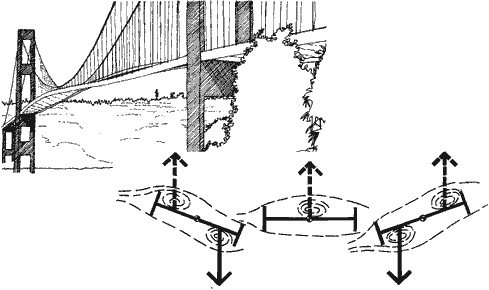
Tacoma Narrows Failure Mechanism - original sketch contributed by Allan Larsen
When the bridge movement changed from vertical to torsional oscillation, the structure absorbed more wind energy. The bridge deck's twisting motion began to control the wind vortex so the two were synchronized. The structure's twisting movements became self-generating. In other words, the forces acting on the bridge were no longer caused by wind. The bridge deck's own motion produced the forces. Engineers call this "self-excited" motion.
It was critical that the two types of instability, vortex shedding and torsional flutter, both occurred at relatively low wind speeds. Usually, vortex shedding occurs at relatively low wind speeds, like 25 to 35 mph, and torsional flutter at high wind speeds, like 100 mph. Because of Gertie's design, and relatively weak resistance to torsional forces, from the vortex shedding instability the bridge went right into "torsional flutter."
Now the bridge was beyond its natural ability to "damp out" the motion. Once the twisting movements began, they controlled the vortex forces. The torsional motion began small and built upon its own self-induced energy.
In other words, Galloping Gertie's twisting induced more twisting, then greater and greater twisting.
This increased beyond the bridge structure's strength to resist. Failure resulted.
What if...?
Sometimes it is fun and worthwhile to ask the question, "What if...?," about important historical events. Here's one with an answer that may surprise you.
What if Clark Eldridge's original design for the 1940 Tacoma Narrows Bridge had been built, instead of Leon Moisseiff's? Would it have blown down on November 7, 1940 like Galloping Gertie?
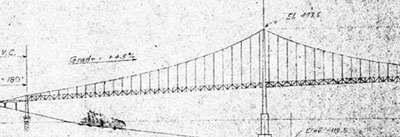
Eldridge's design; elevation detail, May 23, 1938 WSA, WSDOT records
Answer: The bridge would still be there. That's the opinion of leading bridge engineers who have carefully studied Eldridge's design, with its 25-foot deep stiffening truss.
"I believe without a doubt," said one senior structural engineer, "that the bridge would have been aerodynamically stable for the wind speeds that destroyed Galloping Gertie."